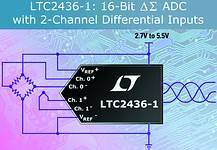16-bit ADC has auto channel selection
23 April 2003
Analogue, Mixed Signal, LSI

Linear Technology's LTC2436-1, a 16-bit No Latency Delta Sigma ADC, offers two fully differential input channels and a differential reference input. The ADC's low noise (800 nV per root-Hz) allows 16-bit performance with full-scale ranges from ±2,5 V down to ±50 mV without a PGA. The No Latency Delta Sigma architecture ensures single cycle digital filter settling even after a change in channels or input voltage step. Transparent auto calibration, on every conversion, ensures stable output codes with a total unadjusted error of 3LSBMAX independent of time, temperature, and supply. The LTC2436-1 can accept two differential inputs, which are converted alternately without being programmed. The full-scale input spans -0,5 VREF to 0,5 VREF where the reference voltage can be anywhere between 0,1 V and VCC for flexible ratiometric and remote sensing configurations. Since the noise performance is independent of VREF, input resolution increases by simply lowering the reference voltage. The LTC2436-1 communicates through a 3-wire digital interface, which is compatible with the SPI protocol. The device operates from a single 2,7 to 5,5 V supply and comes in 16-pin SSOP.
Further reading:
Online sensor technology hub
Analogue, Mixed Signal, LSI
Mouser’s sensor content hub offers an extensive collection of articles, blogs, eBooks, and product information from its technical experts and leading manufacturing partners.
Read more...
Ultra-low power MEMS accelerometer
Altron Arrow
Analogue, Mixed Signal, LSI
Analog Devices’ ADXL366 is an ultra-low power, 3-axis MEMS accelerometer that consumes only 0,96 µA at a 100 Hz output data rate and 191 nA when in motion-triggered wake-up mode.
Read more...
BT Audio 4 Click board
Dizzy Enterprises
Analogue, Mixed Signal, LSI
The BT Audio 4 Click board from MIKROE provides high-quality wireless audio streaming and data comms over Bluetooth.
Read more...
Precision MEMS IMU modules
Altron Arrow
Analogue, Mixed Signal, LSI
The ADIS16575/ADIS16576/ADIS16577 from Analog Devices are precision, MEMS IMUs that includes a triaxial gyroscope and a triaxial accelerometer.
Read more...
MEMS with embedded AI processing
Altron Arrow
Analogue, Mixed Signal, LSI
STMicroelectronics has announced an inertial measurement unit that combines sensors tuned for activity tracking and high-g impact measurement into a single, space-saving package.
Read more...
High-performance IMU
RS South Africa
Analogue, Mixed Signal, LSI
TDK Corporation has announced availability of the new InvenSense SmartMotion ICM-536xx family of high-performance 6-axis IMUs.
Read more...
High-temperature closed-loop MEMS accelerometer
RS South Africa
Analogue, Mixed Signal, LSI
This sensor from TDK is a high-temperature MEMS accelerometer with ±14 g input range and a digital interface for measurement while drilling applications.
Read more...
Dual accelerometers on the same die
Altron Arrow
Analogue, Mixed Signal, LSI
The LSM6DSV320X is the first mainstream inertial sensor to house a gyroscope alongside two accelerometers, one capable of sensing up to ±16 g and one sensing up to a staggering ±320 g.
Read more...
Dual-range IMU with edge processing
EBV Electrolink
Analogue, Mixed Signal, LSI
ST’s innovative LSM6DSV80X combines two accelerometer structures for 16 g and 80 g full-scale sensing, a gyroscope up 4000 dps, and embedded intelligence in a single component.
Read more...
High-reliability isolation amplifiers
EBV Electrolink
Analogue, Mixed Signal, LSI
The VIA series of isolation amplifiers from Vishay are designed to deliver exceptional thermal stability and precise measurement capabilities.
Read more...


